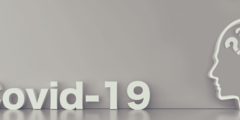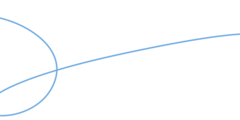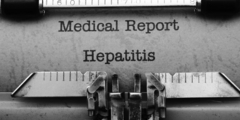
Onze vermogen om te ruiken ontstaat in de ‘reukkolf’ (olfactory bulb). Dit orgaan ligt boven in neusholte en heeft een oppervlakte van 5 cm² en een volume van ongeveer 4,4 mL. De smaak ontstaat in smaakpapillen op de tong, in het slijmvlies van het gehemelte en in de keelholte. Ongeveer 70% van de smaak wordt via de neus opgewekt. Eet met dichtgeknepen neus een sterk gekruid snoepje: slechts een lichte zoete smaak wordt waargenomen. Om dezelfde reden smaakt bij een neusverkoudheid een maaltijd flauw.1-11 Reuk- en smaakverlies is invaliderend. Het komt voor bij 5% van de Nederlanders en is bij COVID-19 het meest voorkomende, en vaak het eerste en enige symptoom.
Beste bezoeker, u heeft geen toegang.
Enkel (web)abonnees hebben toegang tot tijdschriftartikelen. Het webabonnement is nog in de maak.
U kunt zich wel alvast (gratis) registreren en tal van andere webartikelen raadplegen!
Auteur
Verschenen in
Referenties
1. Vokshoor A. Olfactory System Anatomy. Medscape, updated September 25, 2013, accessed 4 Nov 2023
https://emedicine.medscape.com/article/835585-overview?form=fpf
1a. Keel-Neus-Oorheelkunde en Heelkunde van het Hoofd-Halsgebied. Reuk, accessed 4 Nov 2023
https://www.kno.nl/patienten-informatie/neus/reuk/
1b. Keel-Neus-Oorheelkunde en Heelkunde van het Hoofd-Halsgebied. Smaak, accessed 4 Nov 2023
https://www.kno.nl/patienten-informatie/keel/smaak/
2. Capelli S, Caroli A, Barletta A, Arrigoni A, Napolitano A, Pezzetti G, Longhi LG, Zangari R, Lorini FL, Sessa M, Remuzzi A, Gerevini S. MRI evidence of olfactory system alterations in patients with COVID-19 and neurological symptoms. J Neurol. 2023 Mar;270(3):1195-1206. doi: 10.1007/s00415-023-11561-0. Epub 2023 Jan 19. PMID: 36656356; PMCID: PMC9850323.
https://pubmed.ncbi.nlm.nih.gov/36656356/
3. Marrin A. Making Sense of Scents: Smell and the Brain. BrainFacts.org, 27 january 2015, accessed 4 Nov 2023.
https://www.brainfacts.org/thinking-sensing-and-behaving/smell/2015/maki...
4. Glezer I, Malnic B. Olfactory receptor function. Handb Clin Neurol. 2019;164:67-78. doi: 10.1016/B978-0-444-63855-7.00005-8. PMID: 31604564.
https://pubmed.ncbi.nlm.nih.gov/31604564/
5. Ruta V, Reem GH, Kayden HJ. Study reveals how smell receptors work. The Rockefeller University, August 4, 2012, Accessed 4 Nov 2023
https://www.rockefeller.edu/news/30838-study-reveals-smell-receptors-work/
6. Reuksmaakstoornis. Reuksmaakstoornis.nl. Patiëntenvereniging voor mensen met een reuk- en/of smaakstoornis. Accessed 4 Nov 2023
https://reuksmaakstglezeroornis.nl/
7. Reuk- en smaakstoornissen. Reuksmaakstoornis.nl. Patiëntenvereniging voor mensen met een reuk- en/of smaakstoornis. Accessed 4 Nov 2023
https://reuksmaakstoornis.nl/reuk-en-smaakstoornissen/
8. Wat doet het coronavirus met je reuk en smaak? Reuksmaakstoornis.nl. Patiëntenvereniging voor mensen met een reuk- en/of smaakstoornis. Accessed 4 Nov 2023
https://reuksmaakstoornis.nl/reukverliesnacovid19/
9. Minsky L, Fahey C, Fabrigas C. Inside the Invisible but Influential World of Scent Branding. Harvard Business Review, April 11,2018, accessed 4 Nov 2023.
https://hbr.org/2018/04/inside-the-invisible-but-influential-world-of-sc...
10. Walsh C. What the nose knows. The Harvard Gazette, Februray 27,2020, accessed 4 Nov 2023.
https://news.harvard.edu/gazette/story/2020/02/how-scent-emotion-and-mem...
11. De Luca, R., & Botelho, D. (2021). The unconscious perception of smells as a driver of consumer responses: A framework integrating the emotion-cognition approach to scent marketing. AMS Review, 11(1-2), 145-161.
https://link.springer.com/article/10.1007/s13162-019-00154-8
12. Cuffari B. How are Smell and Memory Connected? News Medical Life Sciences. Last Updated: Jan 11, 2021, accessed 4 Nov 2023
https://www.news-medical.net/health/How-are-Smell-and-Memory-Connected.aspx
13. Mouly AM, Sullivan R. Memory and Plasticity in the Olfactory System: From Infancy to Adulthood. In: Menini A, editor. The Neurobiology of Olfaction. Boca Raton (FL): CRC Press/Taylor & Francis; 2010. Chapter 15. PMID: 21882422.
https://pubmed.ncbi.nlm.nih.gov/21882422/
14. Bhatia-Dey N, Csoka AB, Heinbockel T. Chemosensory Ability and Sensitivity in Health and Disease: Epigenetic Regulation and COVID-19. Int J Mol Sci. 2023 Feb 20;24(4):4179. doi: 10.3390/ijms24044179. PMID: 36835589; PMCID: PMC9959623.
https://pubmed.ncbi.nlm.nih.gov/36835589/
15. Elephants have twice as many olfactory receptor genes as dogs — Genome comparison reveals mammalian diversity. The University of Toky0, 2014, accessed 4 Nov 2023
https://www.a.u-tokyo.ac.jp/english/topics_e/topics_2014_e/20140812-1.html
16. Niimura Y, Matsui A, Touhara K. Extreme expansion of the olfactory receptor gene repertoire in African elephants and evolutionary dynamics of orthologous gene groups in 13 placental mammals. Genome Res. 2014 Sep;24(9):1485-96. doi: 10.1101/gr.169532.113. Epub 2014 Jul 22. Erratum in: Genome Res. 2015 Jun;25(6):926. PMID: 25053675; PMCID: PMC4158756.
https://pubmed.ncbi.nlm.nih.gov/25053675/
17. Kishida T. Olfaction of aquatic amniotes. Cell Tissue Res. 2021 Jan;383(1):353-365. doi: 10.1007/s00441-020-03382-8. Epub 2021 Jan 6. PMID: 33409651.
https://pubmed.ncbi.nlm.nih.gov/33409651/
18. Gao S, Liu S, Yao J, Li N, Yuan Z, Zhou T, Li Q, Liu Z. Genomic organization and evolution of olfactory receptors and trace amine-associated receptors in channel catfish, Ictalurus punctatus. Biochim Biophys Acta Gen Subj. 2017 Mar;1861(3):644-651. doi: 10.1016/j.bbagen.2016.10.017. Epub 2016 Oct 21. PMID: 27773705.
https://pubmed.ncbi.nlm.nih.gov/27773705/
19. Syed AS, Sharma K, Policarpo M, Ferrando S, Casane D, Korsching SI. Ancient and Nonuniform Loss of Olfactory Receptor Expression Renders the Shark Nose a De Facto Vomeronasal Organ. Mol Biol Evol. 2023 Apr 4;40(4):msad076. doi: 10.1093/molbev/msad076. PMID: 36971115; PMCID: PMC10116579.
https://pubmed.ncbi.nlm.nih.gov/36971115/
20. Gilad Y, Lancet D. Population differences in the human functional olfactory repertoire. Mol Biol Evol. 2003 Mar;20(3):307-14. doi: 10.1093/molbev/msg013. PMID: 12644552.
https://pubmed.ncbi.nlm.nih.gov/12644552/
21. Wessels Q, Hoogland PV, Vorster W. Anatomical evidence for an endocrine activity of the vomeronasal organ in humans. Clin Anat. 2014 Sep;27(6):856-60. doi: 10.1002/ca.22382. Epub 2014 Feb 19. PMID: 24554552.
https://pubmed.ncbi.nlm.nih.gov/24554552/
22. Bruintjes TD, Bleys RLAW. The clinical significance of the human vomeronasal organ. Surg Radiol Anat. 2023 Apr;45(4):457-460. doi: 10.1007/s00276-023-03101-2. Epub 2023 Feb 9. PMID: 36759365; PMCID: PMC10039832.
https://pubmed.ncbi.nlm.nih.gov/36759365/
23. Grain A, Camuset M, Gras-Leguen C, Hardouin JB, Scherdel P, Caldari D. Taste and smell alterations affect nutritional status in children under chemotherapy. Acta Paediatr. 2023 Oct;112(10):2231-2238. doi: 10.1111/apa.16889. Epub 2023 Jul 12. PMID: 37376794.
https://pubmed.ncbi.nlm.nih.gov/37376794/
24. Buttiron Webber T, Briata IM, DeCensi A, Cevasco I, Paleari L. Taste and Smell Disorders in Cancer Treatment: Results from an Integrative Rapid Systematic Review. Int J Mol Sci. 2023 Jan 28;24(3):2538. doi: 10.3390/ijms24032538. PMID: 36768861; PMCID: PMC9916934.
https://pubmed.ncbi.nlm.nih.gov/36768861/
25. Karamali K, Elliott M, Hopkins C. COVID-19 related olfactory dysfunction. Curr Opin Otolaryngol Head Neck Surg. 2022 Feb 1;30(1):19-25. doi: 10.1097/MOO.0000000000000783. PMID: 34889850; PMCID: PMC8711304.
https://pubmed.ncbi.nlm.nih.gov/34889850/
26. Max-Planck-Gesellschaft. SARS-CoV-2 infects sustentacular cells in the olfactory epithelium of COVID-19 patients. November 24, 2021, accessed 4 nNov 2023.
https://www.mpg.de/17907472/corona-sense-of-smell
27. Whitcroft KL, Altundag A, Balungwe P, Boscolo-Rizzo P, Douglas R, Enecilla MLB, Fjaeldstad AW, Fornazieri MA, Frasnelli J, Gane S, Gudziol H, Gupta N, Haehner A, Hernandez AK, Holbrook EH, Hopkins C, Hsieh JW, Huart C, Husain S, Kamel R, Kim JK, Kobayashi M, Konstantinidis I, Landis BN, Lechner M, Macchi A, Mazal PP, Miri I, Miwa T, Mori E, Mullol J, Mueller CA, Ottaviano G, Patel ZM, Philpott C, Pinto JM, Ramakrishnan VR, Roth Y, Schlosser RJ, Stjärne P, Van Gerven L, Vodicka J, Welge-Luessen A, Wormald PJ, Hummel T. Position paper on olfactory dysfunction: 2023. Rhinology. 2023 Jul 16. doi: 10.4193/Rhin22.483. Epub ahead of print. PMID: 37454287.
https://pubmed.ncbi.nlm.nih.gov/37454287/
28. Finlay JB, Brann DH, Abi Hachem R, Jang DW, Oliva AD, Ko T, Gupta R, Wellford SA, Moseman EA, Jang SS, Yan CH, Matsunami H, Tsukahara T, Datta SR, Goldstein BJ. Persistent post-COVID-19 smell loss is associated with immune cell infiltration and altered gene expression in olfactory epithelium. Sci Transl Med. 2022 Dec 21;14(676):eadd0484. doi: 10.1126/scitranslmed.add0484. Epub 2022 Dec 21. PMID: 36542694; PMCID: PMC10317309.
https://pubmed.ncbi.nlm.nih.gov/36542694/
29. van Riel D, Leijten LM, Verdijk RM, GeurtsvanKessel C, van der Vries E, van Rossum AM, Osterhaus AD, Kuiken T. Evidence for influenza virus CNS invasion along the olfactory route in an immunocompromised infant. J Infect Dis. 2014 Aug 1;210(3):419-23. doi: 10.1093/infdis/jiu097. Epub 2014 Feb 18. PMID: 24550441.
https://pubmed.ncbi.nlm.nih.gov/24550441/
30. van Riel D, Verdijk R, Kuiken T. The olfactory nerve: a shortcut for influenza and other viral diseases into the central nervous system. J Pathol. 2015 Jan;235(2):277-87. doi: 10.1002/path.4461. PMID: 25294743.
https://pubmed.ncbi.nlm.nih.gov/25294743/
31. Khan AM, Lee J, Rammaha T, Gupta S, Smith H, Kannampallil T, Farrell N, Kallogjeri D, Piccirillo JF. Natural trajectory of recovery of COVID-19 associated olfactory loss. Am J Otolaryngol. 2022 Sep-Oct;43(5):103572. doi: 10.1016/j.amjoto.2022.103572. Epub 2022 Aug 6. PMID: 35969913; PMCID: PMC9355743.
https://pubmed.ncbi.nlm.nih.gov/35969913/
32. Wu TJ, Yu AC, Lee JT. Management of post-COVID-19 olfactory dysfunction. Curr Treat Options Allergy. 2022;9(1):1-18. doi: 10.1007/s40521-021-00297-9. Epub 2022 Jan 4. PMID: 35004126; PMCID: PMC8723803.
https://pubmed.ncbi.nlm.nih.gov/35004126/





